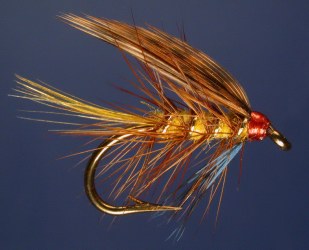Invicta Flies - Invicta
The Invicta is a classic British wet fly, imitative of the diving sedge, or caddis. A very good pattern on still waters and has produced many panfish and largemouth bass for me as well in the warmer waters. My absolute favorite fly.

Hook: Mustad 3906, #14-10
Thread: Danville Prewaxed 6/0 black or reddish brown
Tail: golden pheasant crest
Body: yellow seal fur or similar dubbing
Ribbing: fine oval goal tinsel
Hackle: natural brown palmered over body
Throat: European jay (or substitute guinea hen dyed blue)
Wing: hen pheasant center tail or wing quill segment
Head: tying thread
Tying Instructions:
1) Place hook in vise and secure thread. Bring forward to just behind eye.
2) Tie in about ten fibers of blue guinea hen, not quite as long as the hook shank, on underside of hook, tips extending forward beyond eye.
3) Wind thread back to hook bend. Tie in a golden pheasant crest feather for the tail, length about equal to hook length. Tail should curve up. To help you acheive this, hold crest against shank, leaning slightly toward you. Take a couple loose turns of thread around it and the shank, then pull down with even pressure. The thread torque should bring the fibers up on top of the shank.
4) Tie in ribbing, portion to be wound extending beyond bend, directly on top of shank.
5) Tie in the hackle by its tip, darker side forward. Use a feather with fibers just slightly longer than the hook gap.
6) Dub a body forward to one and a half hook eye lengths behind eye. As a seal substiute, I use a blend of half yellow angora goat hair and half yellow rabbit fur.
7) Wind the ribbing forward and tie off. Clip excess.
8) Wind hackle forward, tight against the ribbing. Tie off and clip.
9) Clip segments from a matching pair of hen pheasant wing quills, width equal to 3/4 hook gap. Place back to back and tie in directly on top of shank, tip extending to almost touch tip of tail. Clip excess butts. Other feathers, such as hen pheasant center tail, woodcock, snd grouse, are also used.
10) Fold blue guinea hen fibers back and secure under wing tie-down area with thread wraps. These fibers should end up being slightly longer than the body hackle.
11) Form a full, rounded head of tying thread. Whip finish and cement to create a glossy head.
Variations: Substitute different body colors to match local caddis. The olive body version has produced very well for me. The Silver Invicta is tied much the same way, using silver tinsel for the body instead of dubbing, and fine oval silver tinsel for the ribbing. This particular version is good just about any time.